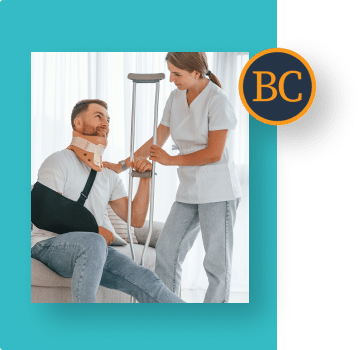
1. Seek medical treatment
Individuals who have been injured should seek immediate medical attention after a slip and fall accident, even if the injuries are seemingly minor. Being examined by a medical professional after the accident may reveal additional injuries or uncover injuries that may have been aggravated by the accident.
Seeking medical treatment can support your slip and fall claim by documenting injuries throughout the legal process. In most cases, slip and fall cases settle within 9-12 months after treatment is complete. Generally, this means that cases where medical treatment is completed quickly will reach a settlement sooner than those where delays or lapses in treatment occur.
Note: If you or a loves one has experienced pain after a fall, see what to do after a slip and fall accident. Even some more severe injuries and symptoms can be delayed and present themselves days after a fall.
2. File an accident report
The next step of a slip and fall lawsuit is for the claimant to file an accident report. In most cases, this applies to accidents that occurred at a business (also referred to as an incident report).
Here are several steps to follow for filing an accident report to help document your case:
- Create awareness – Whether on private or public property, make the property owner or manager on duty aware of the accident. If the accident occurred at work, contact a supervisor. Most businesses will have a company policy to follow, which will help to provide further documentation of the accident, and ensure that medical attention is available if needed.
- Complete an accident report – In many cases, you’ll be required to sign off on the accident report. This will include the time, location, and any known injuries that resulted from the accident.
- Photograph evidence – Evidence such as hazardous conditions (e.g. wet floor or icy pavement) and any injuries should be photographed as evidence to support your slip and fall claim. Any photos taken should accurately and clearly represent the scene of the accident and associated injuries. Additionally, photos should also be taken if the injuries progress or worsen over time. Family members or close friends can help with this step.
3. Gather evidence
If you’ve followed the previous steps, you should have sufficient evidence to support your slip and fall claim.
Here’s everything that should be documented:
- Accident location.
- Time & date of the accident.
- Accident report.
- Cause of the accident (wet floors, icy pavement, etc.).
- Witnesses and any witness statements.
- Any supporting photos that show the hazardous condition and injuries.
- Medical records associated with treatment, check-ins, or surgery.
- Proof of lost wages from employer (if work was missed due to injuries).
At this stage, it’s important to consult a personal injury lawyer for help with your case. Most personal injury attorneys work on a contingency fee basis, meaning there are no legal fees unless there’s a mutual agreement for them to represent your case.
Consulting with a lawyer at this stage can help you get answers to any legal questions you may have about your case, help you understand any legal considerations that may apply, and help determine if hiring a law firm would be beneficial.
4. File a claim
At this stage, you may choose to file an insurance claim, or take the slip and fall lawsuit to court.There are two important considerations:
- Statute of limitations – Depending on your state, your claim must be filed within a certain time frame that begins on the date the injury occurred. For example, the Missouri statute of limitations for slip and fall claims states that individuals have 5 years from the date of the accident to file a lawsuit.
- 90-day municipal notice – When the defendant of a slip and fall claim is a city or city entity, then the regular statute of limitation applies. However, the injured party must provide the relevant municipal entity a 90 days’ notice of the following: the place where the injury occurred, the time when such injury was received, the character and circumstances of the injury, and that the person injured will claim damages therefore from such city.
- Proving negligence – No matter your state, property owner negligence must be proved. This means your claim must evidence that the property owner failed to uphold or meet certain conditions that would have prevented the accident from occurring. For example, a property owner might argue that the average individual would have noticed a wet floor, and taken the appropriate measures to avoid slipping on it.
Again, you may choose to get help with a personal injury or slip and fall lawyer at this step for additional guidance and specific considerations that may apply to your claim.


Were you injured in an accident due to someone else’s negligence? Get legal help from the most effective injury law firm in the Midwest.
HOW A SLIP AND FALL LAWYER CAN HELP
A slip and fall lawyer can help you determine the best course of action for your case (claim versus lawsuit), collect evidence, and help you build a strong case to support your claim.
If you or a loved one has been injured as a result of a slip and fall accident, request a free case evaluation from our legal team to get started with your slip and fall case. We’ve helped our clients recover over $1 billion as a result of settlements and verdicts, including slip and fall accidents.







